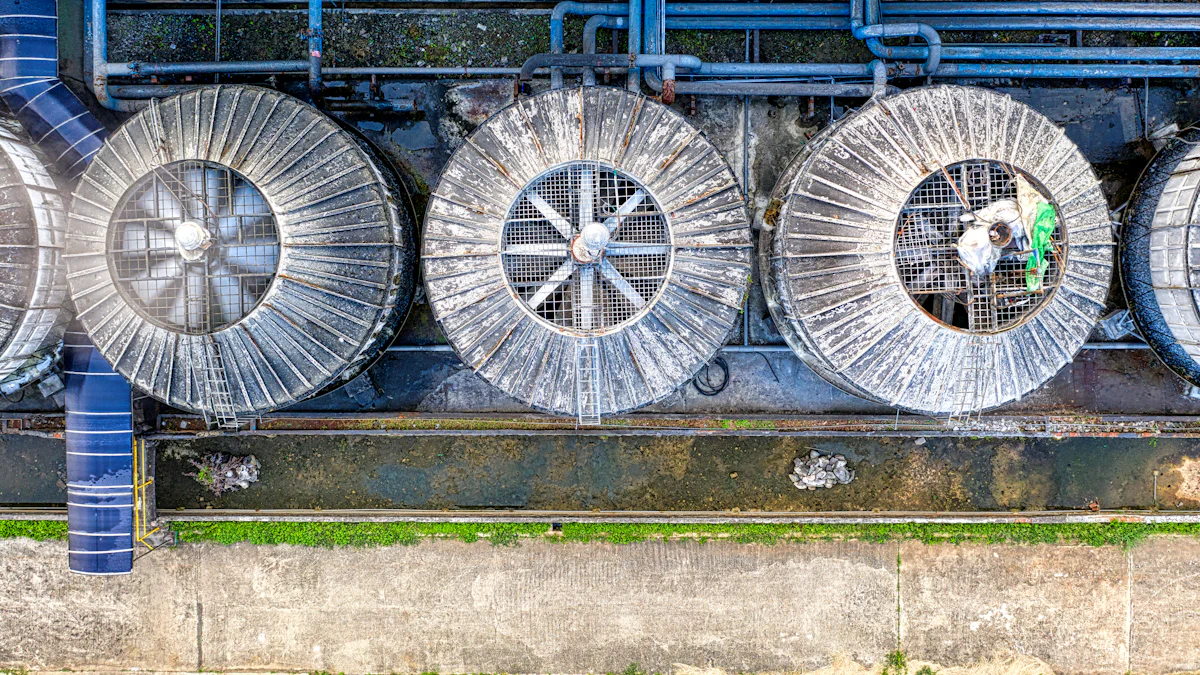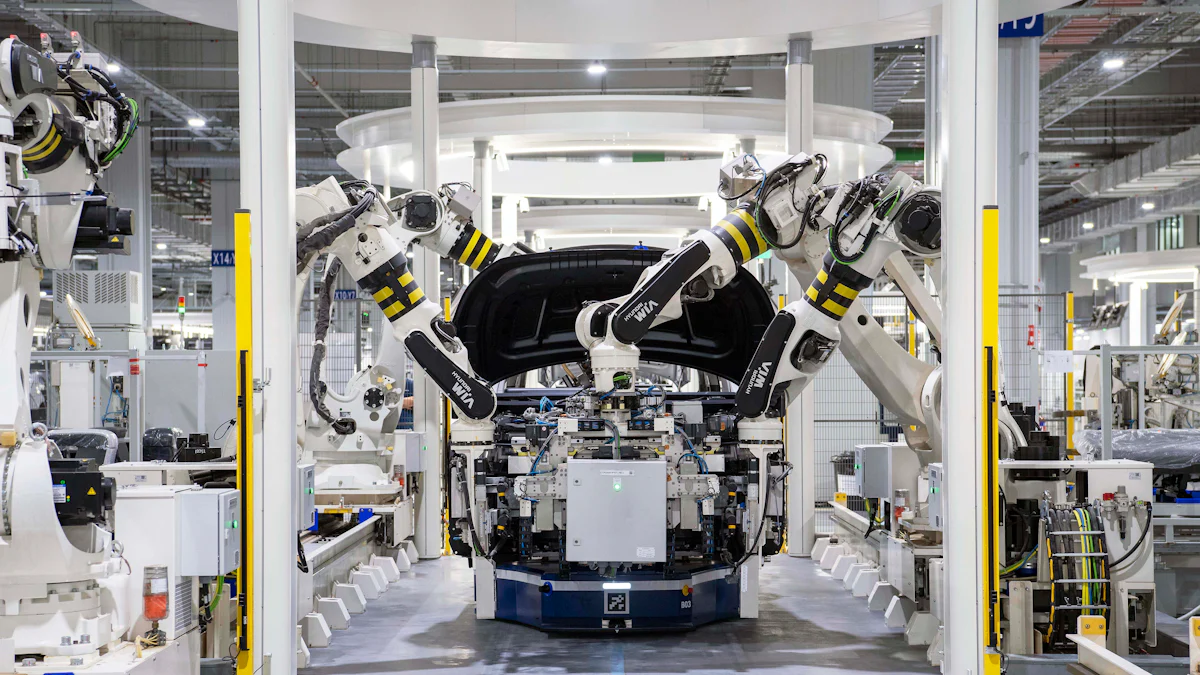Understanding the Essentials of Industrial Fan Specs

Understanding fan industrial specifications is crucial for optimizing performance and reducing operating costs. Industrial fans rank third in energy consumption among industrial devices, consuming approximately 300 TWh annually. Specifications guide you in selecting the right industrial fan for your needs, ensuring efficiency and reliability. Key factors include airflow capacity, energy efficiency, and noise levels. Recognized certifications like ENERGY STAR indicate high-efficiency models. By grasping these specs, you can make informed decisions that enhance system performance and sustainability.
Basic Concepts of Industrial Fan Specifications
Definitions and Terminology
What are Industrial Fan Specs?
Industrial fan specifications provide essential details about a fan's design and performance. These specs help users select the right fan for specific applications. Specifications include dimensions, airflow capacity, and noise levels. Manufacturers like NYB and Air King offer detailed spec sheets for their products. These sheets ensure that users can make informed decisions.
Key Terms and Definitions
Understanding key terms is crucial when evaluating industrial fan specs. Airflow, measured in cubic feet per minute (CFM), indicates the volume of air a fan moves. Static pressure, often expressed in inches of water gauge, measures resistance to airflow. Efficiency relates to how well a fan converts electrical energy into airflow. Noise levels, measured in decibels (dBA), indicate how loud a fan operates. Familiarity with these terms aids in selecting the appropriate fan.
Importance of Fan Specifications
Role in Performance and Efficiency
Fan specifications play a vital role in determining performance and efficiency. High-performance fans deliver optimal airflow while consuming less energy. The Super Duty Fan SD5V exemplifies efficiency with its advanced design. Properly selected fans enhance system performance and reduce energy costs. Efficiency metrics guide users in choosing fans that meet operational needs.
Impact on Operational Costs
Operational costs significantly depend on fan specifications. Efficient fans lower energy consumption, reducing utility bills. Fans with high static pressure capabilities maintain performance under challenging conditions. Noise levels also impact operational environments. Quiet fans improve workplace comfort and productivity. Selecting fans based on specs ensures cost-effective and efficient operations.
Detailed Explanation of Fan Specifications
Performance Parameters
Airflow and Pressure
Airflow represents the volume of air an industrial fan moves. Engineers measure airflow in cubic feet per minute (CFM). High airflow ensures efficient cooling and ventilation in industrial settings. Static pressure measures the resistance against airflow. Fans must overcome this resistance to maintain performance. Engineers often express static pressure in inches of water gauge. A balance between airflow and pressure is crucial for optimal fan operation.
Power Consumption and Efficiency
Power consumption directly impacts operational costs. Efficient fans convert electrical energy into airflow with minimal waste. Energy-efficient fans reduce electricity bills and environmental impact. The ENERGY STAR label identifies high-efficiency models. Advanced designs, such as variable length impeller blades, enhance efficiency. These designs adjust flow parameters dynamically. This adaptability optimizes performance across varying conditions.
Design and Construction
Materials and Durability
Material selection influences fan durability. Industrial fans often use metals like aluminum or steel. These materials withstand harsh environments. Corrosion-resistant coatings extend lifespan. Manufacturers prioritize robust construction for reliability. Durable fans require less maintenance and replacement. This longevity reduces long-term costs.
Noise Levels and Vibration
Noise levels affect workplace comfort. Fans produce noise measured in decibels (dBA). Lower noise levels improve employee productivity. Engineers design fans to minimize vibration. Balanced blades reduce mechanical stress. Quiet operation enhances user experience. Proper installation further reduces noise and vibration. Selecting fans with low noise specifications benefits industrial environments.
Practical Applications and Considerations

Installation Density
Factors Affecting Installation
Installation density significantly impacts the performance of an industrial fan. Several factors influence the optimal placement of fans within a facility. Space constraints often dictate the arrangement of equipment, affecting airflow patterns. Obstructions such as beams or machinery can disrupt airflow, reducing efficiency. Engineers must consider these elements when planning installations to ensure effective cooling and ventilation.
Optimization Techniques
Optimization techniques enhance the effectiveness of fan installations. Proper spacing between fans prevents airflow interference, maximizing performance. Engineers can use computational fluid dynamics (CFD) simulations to predict airflow patterns and identify potential issues. Adjusting fan speed through variable speed controls allows for precise airflow management. A case study in a pharmaceutical manufacturing facility demonstrated improved airflow uniformity by installing high-efficiency centrifugal fans with adjustable speed controls and redesigning ductwork.
Impedance and Its Effects
Understanding Impedance
Impedance in industrial fans refers to resistance that affects airflow and pressure. High impedance can lead to reduced fan efficiency and increased energy consumption. Engineers measure impedance to evaluate the impact on system performance. Understanding impedance helps in selecting fans that can overcome resistance and maintain optimal operation.
Managing Impedance for Better Performance
Managing impedance involves selecting fans with appropriate specifications. Fans with higher static pressure capabilities can better handle impedance challenges. Engineers can also modify ductwork design to minimize resistance. Regular maintenance, such as cleaning filters and removing obstructions, reduces impedance and enhances performance. By addressing impedance, facilities can achieve better energy efficiency and operational reliability.
Fan Selection Criteria
Assessing Application Needs
Assessing application needs is crucial for selecting the right industrial fan. Engineers must evaluate the specific requirements of the environment where the fan will operate. Factors such as temperature, humidity, and air quality influence fan selection. Understanding these conditions ensures that the chosen fan meets performance expectations.
Guidelines for Choosing the Right Fan
Choosing the right fan involves following specific guidelines. First, determine the required airflow and pressure based on the application. Next, consider the energy efficiency and noise levels of potential fan models. Look for certifications like ENERGY STAR to identify high-efficiency options. Evaluate the durability and materials of the fan to ensure longevity. By adhering to these guidelines, you can select a fan that optimizes performance and reduces operational costs.
Understanding industrial fan specifications empowers you to enhance system performance and energy efficiency. Recognizing key parameters like airflow, pressure, and noise levels ensures optimal fan selection. Airflow Sciences highlights that informed decisions optimize designs and boost efficiency. Pertecnica Engineering emphasizes real-world applications for effective operations. Engage with experts or sales representatives for tailored advice. This collaboration helps in selecting the right fan for your needs.
See Also
Common Mistakes to Avoid When Choosing Industrial Fans
Effective Cooling Methods of Industrial Fans That Surprise
Utilitech 24-Inch Industrial Fan: A Black Indoor Cooling Solution
About US
X-HON
X- HON is a leading manufacturer of cooling fans,speciaizing in research, development, and production forover a decade. With a focus on quaity and inovation, we ofer arange of cooling solutions to global markets, ensuring superior performance and reliable service.
Address
Address1: HuaYuan Building, Xixiang Avenue, Bao'anDistrict, Shenzhen, Guangdong Province, china;
Address2: DaLingShan District, DongGuan,Guangdong Province, china
Contacts
frelin.jiang@x-hon.com
bella.cai@x-hon.com
+86 15626528321
To inquire about product specifications or to request custom fan designs,
please leave your email address.
Our dedicated service team will be in contact with you shortly.

